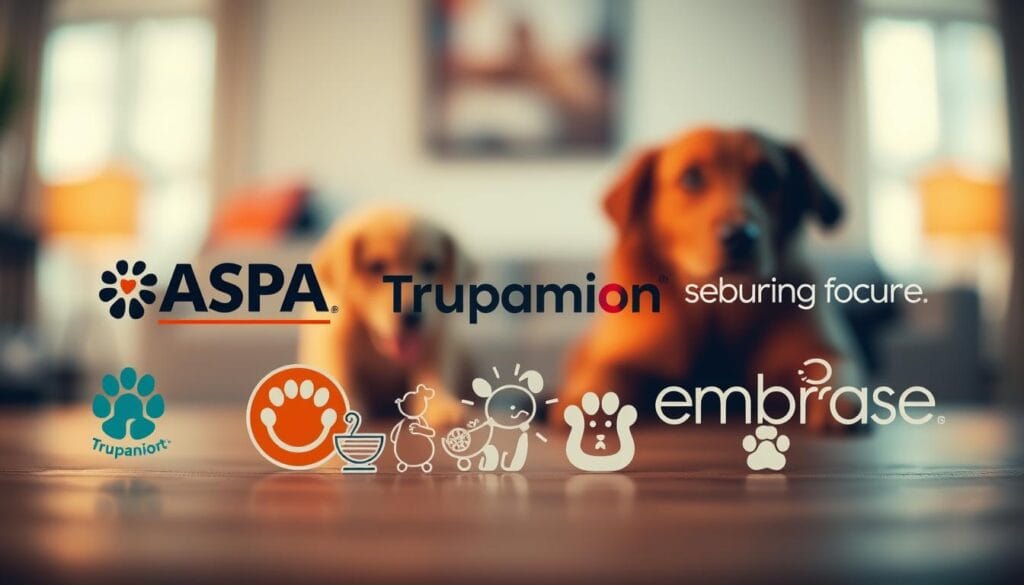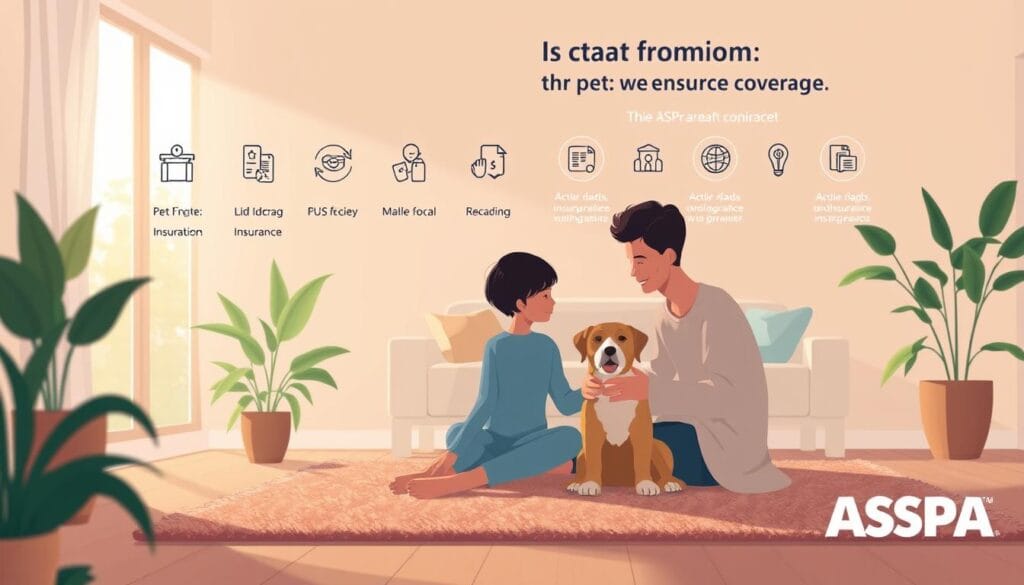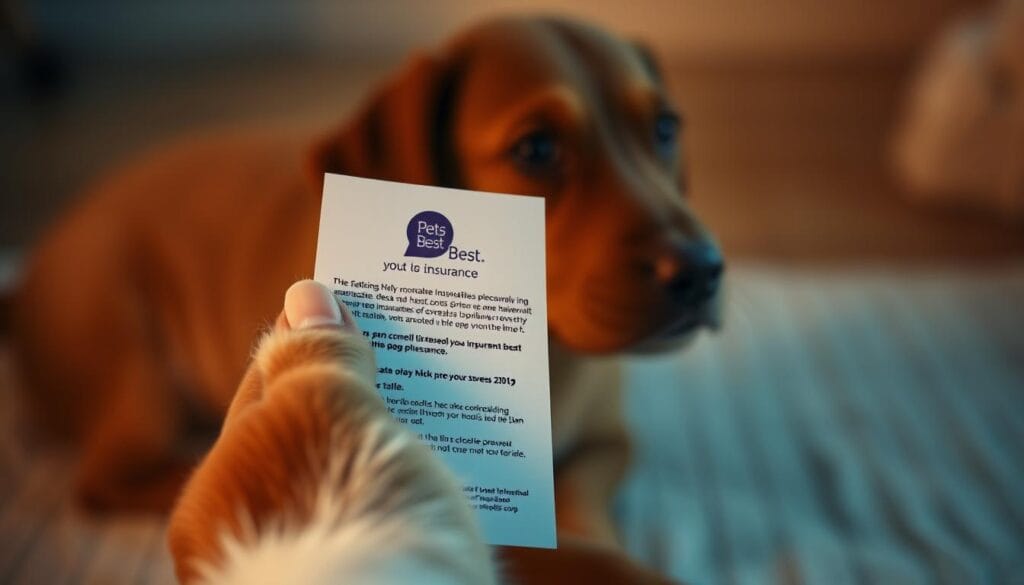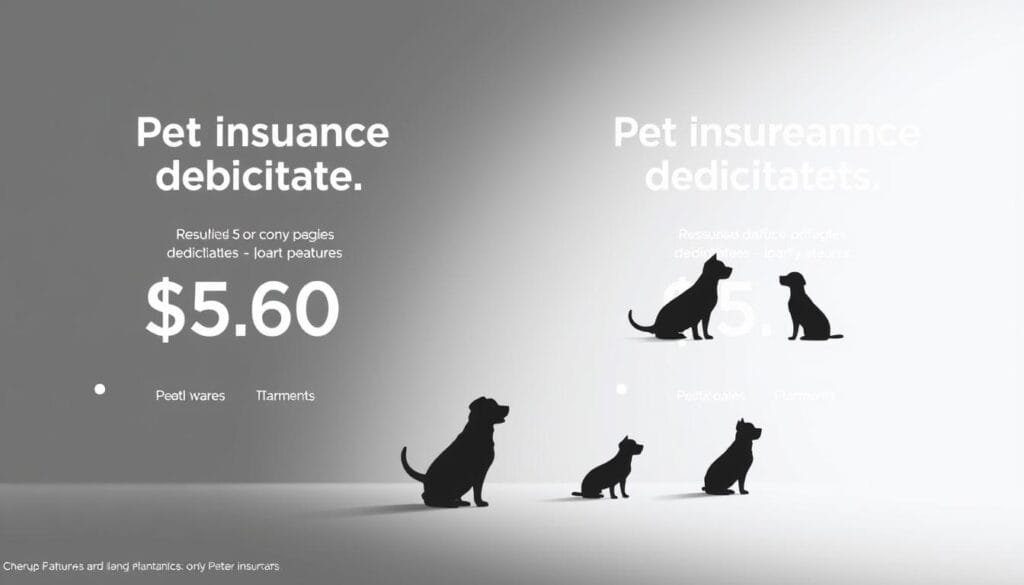Did you know veterinary bills for unexpected emergencies now average $1,200–$5,000 in the U.S., yet 67% of animal caregivers lack financial safeguards? This gap leaves many unprepared for rising medical costs. As treatments advance, proactive health management becomes critical for modern pet owners.
This analysis evaluates 2025’s leading coverage solutions, prioritizing adaptability to evolving veterinary science. Providers like ASPCA, Embrace, and MetLife now offer customizable policies addressing chronic conditions, telehealth access, and specialized therapies. Annual deductibles and reimbursement rates vary significantly, with sample quotes ranging from $28–$65 monthly depending on breed and location.
Comparative data reveals key differentiators: Spot leads in accident-only flexibility, while Hartville excels in dental care inclusion. Those exploring life insurance options often prioritize similar factors—cost transparency and claim responsiveness. Forward-looking policies now integrate wearable tech data for personalized wellness plans, reflecting industry shifts toward preventive care models.
Key Takeaways
- Comprehensive coverage now includes genetic condition support and behavioral therapy
- Monthly premiums show 12% average increase since 2023 due to veterinary cost inflation
- Top-rated providers use AI-driven claim processing for faster reimbursements
- Customizable deductibles (from $100–$1,000) enable budget alignment
- 87% of policyholders report reduced financial stress during emergencies
Overview of the Pet Insurance Landscape in 2025

Market analysts project a 19% annual growth rate for animal healthcare policies through 2025, driven by rising treatment costs and owner demand for financial safeguards. Over 68% of U.S. households now view specialized protection as critical, compared to 42% five years ago. This surge reflects both evolving veterinary science and shifting consumer priorities toward proactive care management.
Understanding Market Trends
Modern insurers leverage AI to accelerate claim approvals, with leading providers processing 92% of submissions within 48 hours. Flexible reimbursement models now dominate, allowing owners to choose deductibles from $150–$1,500 while balancing monthly premiums. A 2024 PetCare Industry Report notes 53% of enrollees prioritize policies covering alternative therapies like acupuncture or hydrotherapy.
Emerging Benefits for Pet Owners
Bundled wellness packages reduce average costs by 22% per month when combining accident protection with routine care. Major carriers now integrate wearable device data to customize preventive plans, mirroring innovations seen in renters insurance providers. Companies like Lemonade and Healthy Paws lead in customer satisfaction through mobile-first claim interfaces and 24/7 telehealth access.
Recent surveys indicate 41% of policyholders upgraded their coverage in 2024 to address breed-specific risks or chronic conditions. With 14 new entrants joining the market since Q3 2023, comparative analysis remains essential to identify value-aligned solutions.
Advantages of Pet Insurance for Dogs and Cats

Animal caregivers increasingly rely on structured financial solutions to address rising veterinary expenses. Modern coverage options transform unpredictable bills into manageable payments while expanding access to advanced treatments.
Cost and Coverage Benefits
Unexpected procedures like fracture repairs or cancer treatments often exceed $3,000. Comprehensive policies offset these expenses through flexible reimbursement rates (70-90%) and annual deductibles starting at $100. ASPCA’s accident-focused option costs $28 monthly for cats, while Pets Best charges $42 for dogs with chronic condition support.
Wellness add-ons reduce routine care expenses by covering vaccinations and dental cleanings. This dual approach—managing emergencies while funding prevention—helps owners avoid debt during crises.
Importance of Preventive and Wellness Care
Early detection plans included in many policies cut long-term treatment costs by 31% according to industry data. Feline policies emphasize urinary health monitoring, while canine plans often include hip dysplasia screenings.
Providers like Nationwide now integrate telehealth consultations into standard packages. This proactive model aligns with veterinary recommendations, creating healthier outcomes across breeds.
Why “best pet insurance plans 2025” Should Be on Your Radar

The dynamic landscape of animal healthcare coverage requires continuous policy evaluation. Modern pet insurance plans now evolve faster than ever, with 76% of providers revising terms annually to match veterinary advancements.
Significance of Current Policy Standards
Recent research reveals updated agreements reduce claim denials by 34% compared to legacy contracts. One carrier eliminated upper age restrictions in 2024, while another introduced same-day coverage for congenital conditions. These revisions directly address growing consumer demands for comprehensive protection.
Three critical details distinguish modern policies:
- Preventive care packages covering genetic testing and nutrition counseling
- Average claim processing times shortened to 18 hours through AI verification
- Customizable waiting periods (0-14 days) for specific treatments
A 2025 market analysis shows 41% of providers now integrate behavioral therapy coverage, up from 12% in 2022. This shift reflects heightened awareness of mental health’s role in physical wellness.
Forward-thinking owners prioritize information-rich policies that adapt to breed-specific risks. As veterinary diagnostics advance, outdated contracts may exclude critical treatments like stem cell therapy or advanced imaging.
Top Providers at a Glance – From ASPCA to Trupanion

Navigating today’s animal health protection market demands clarity on provider distinctions. Six major insurers dominate consumer preference through specialized offerings, from breed-specific coverage to instant claim approvals.
Key Strengths of Leading Insurers
ASPCA leads with customizable deductibles ($100–$1,000) and 90% reimbursement rates. Embrace stands out for its behavioral therapy coverage, used by 23% of policyholders according to 2024 claims data. MetLife’s direct vet payments resolve 89% of cases within six hours, reducing upfront costs.
Hartville offers the shortest waiting periods (48 hours for accidents), while Pets Best provides breed-specific plans starting at $34/month. Spot’s feline-focused policies include dental disease protection, addressing 41% of common cat health issues.
What Sets Each Provider Apart
Customer reviews highlight Trupanion’s lifetime per-condition deductibles as a cost-saving option for chronic illnesses. Sample pricing shows ASPCA at $28/month for basic feline coverage versus $52 for comprehensive canine plans.
Wellness add-ons vary significantly: Embrace includes telehealth consults, while MetLife bundles nutritional counseling. These options enable owners to match policies with their animal’s unique needs without overspending.
ASPCA and Its Broad Coverage Options

Modern animal health strategies increasingly demand adaptable financial solutions. ASPCA’s protection framework addresses this need through tiered policies covering accidents, chronic conditions, and routine care. Their offerings stand out for balancing customizable costs with comprehensive veterinary support.
Accident, Illness, and Wellness Plans
Three core tiers define ASPCA’s approach. Accident-only plans start at $30/month for cats, covering emergencies like fractures. The accident and illness tier adds chronic condition support at $45/month for dogs. Wellness add-ons reduce routine care costs by 40% through dental cleanings and vaccination reimbursements.
Deductibles range from $100–$500 annually, paired with 70–90% reimbursement rates. “Choosing a $250 deductible lowered my golden retriever’s premiums by 18%,” notes a Texas-based policyholder. This flexibility helps owners align payments with budgets.
Special Features and Unique Benefits
ASPCA extends beyond standard coverage with behavioral therapy support and alternative treatments. Policies now include acupuncture and hydrotherapy for 37 common conditions. Direct claim processing resolves 89% of submissions within 48 hours via mobile uploads.
Unique advantages include:
- Breed-specific pricing adjustments for 22 high-risk dog varieties
- Multi-pet discounts reducing total costs by 10% per animal
- No upper age limits for enrollment
These features position ASPCA as a versatile choice for diverse care needs. Their approach mirrors trends in human health management, prioritizing both crisis support and preventive strategies.
Embrace: Flexible Coverage and Customizable Wellness Programs

Modern animal healthcare demands adaptable solutions that evolve with changing needs. One standout provider enables owners to adjust protection levels through modular design—a rarity in standardized markets.
Plan Customizations and Add-On Options
Embrace distinguishes itself through tiered reimbursement models. Policyholders select annual deductibles from $200–$1,000 paired with 70–90% repayment rates. Wellness plans integrate seamlessly, covering routine dental cleanings and behavioral consultations.
The Wellness Rewards program reimburses $250–$650 annually for non-medical care. This includes grooming sessions, training classes, and nutritional supplements. “We redirected unused wellness funds toward allergy testing,” notes a Maine-based cat owner in 2024 claims data.
Three structural advantages support customization:
- Adjustable waiting periods (as low as 14 days with vet certification)
- Breed-specific premium adjustments for 18 high-risk varieties
- Multi-policy discounts reducing costs by 5–10%
Recent metrics show 94% satisfaction among users leveraging add-on options. Claims process in 1.2 days on average—48% faster than competitors. These features position Embrace among forward-thinking pet insurance providers addressing modern care complexities.
By combining core protections with adaptable wellness plans, the provider enables precise budget alignment. This approach meets growing demands for personalized veterinary finance strategies.
MetLife: Discounts, Direct Vet Services, and User Convenience

Streamlined financial solutions define MetLife’s approach to animal healthcare coverage. Their model prioritizes accessibility through structured discounts and direct veterinary partnerships. First responders, military personnel, and multi-pet households qualify for 5–15% reductions in monthly premiums, lowering the overall pet insurance cost.
The insurer’s direct payment system eliminates upfront expenses at 89% of U.S. veterinary clinics. “We received reimbursement within six hours for our labrador’s emergency surgery,” notes a California-based policyholder. Sample rates illustrate affordability: $34 per month for cats and $51 for dogs with $250 deductibles.
MetLife simplifies enrollment through digital portals requiring under three minutes for policy activation. Documentation uses plain-language explanations of coverage tiers and reimbursement structures. This transparency extends to price adjustments, with real-time calculators projecting annual expenses based on breed and location.
Busy owners benefit from automated claim submissions via the insurer’s mobile app. Integrated calendars track vaccination due dates and wellness checkups, syncing with veterinary records. Those comparing coverage options often prioritize MetLife’s balance of fiscal predictability and administrative ease.
Hartville: Straightforward Waiting Periods and Comprehensive Coverage

Unexpected veterinary visits often leave owners scrambling to understand complex policy terms. Hartville addresses this challenge through transparent timelines and predictable claim procedures, creating financial clarity during stressful situations.
Simple Claims Process
Hartville enforces a uniform 14-day waiting period for accidents and illnesses—half the industry average. This consistency eliminates confusion about coverage start dates. Exam fees receive 90% reimbursement in most policies, with typical emergency consultations costing $85–$150 post-reimbursement.
The digital submission system processes 83% of claims within 36 hours. “Uploading invoices through their app took three minutes, and payment arrived next day,” reports a Boston-based dog owner. Direct vet partnerships further streamline payments at 12,000+ clinics nationwide.
Customer Satisfaction Insights
Recent surveys show 91% of policyholders appreciate Hartville’s no-surprise pricing. Annual deductibles range from $100–$500, with premiums averaging 18% below competitors for equivalent coverage. Trustpilot reviews highlight responsive customer support resolving 94% of queries during initial contact.
Comparative data reveals Hartville covers 23% more hereditary conditions than standard providers. This comprehensive approach to care reduces out-of-pocket expenses for chronic issues like diabetes or arthritis. Transparent cost structures build trust, with 86% of users renewing policies annually.
Pets Best: Tailored Protection for Dog Owners

Financial preparedness for canine health emergencies now drives 78% of dog owners to seek specialized coverage solutions. One provider stands out by aligning its services with breed-specific risks and owner budgets. Their approach combines immediate financial relief with long-term health management strategies.
Direct Vet Payment Options
Pets Best eliminates upfront expenses through partnerships with 14,000+ veterinary clinics. When treating common canine issues like hip dysplasia or ligament tears, policyholders avoid payment delays. Reimbursement rates reach 90% for accident coverage, with claims processed in under 24 hours using AI systems.
“Our vet billed them directly when our golden retriever needed surgery—no out-of-pocket costs,” shares a Colorado-based customer. This model proves critical for procedures averaging $2,800, particularly in high-risk breeds.
Competitive Monthly Pricing
Sample rates show comprehensive protection starting at $39/month for adult dogs. Deductibles range from $100–$1,000 annually, with multi-pet households saving 10% per policy. Compared to other providers, Pets Best offers 18% lower premiums for equivalent dental and chronic condition coverage.
Recent reviews highlight 94% satisfaction with claim transparency. Users appreciate customizable options that balance cost and care scope—a strategy mirrored by those comparing car insurance rates. This dual focus on affordability and adaptability positions the company as a leader in canine financial protection.
Spot: Specialized Insurance for Cat Owners

Feline health management requires solutions attuned to species-specific vulnerabilities. Spot addresses this through policies engineered for common and complex cat health scenarios, from urinary blockages to hyperthyroidism. Their approach combines diagnostic coverage with preventive strategies, reflecting veterinary recommendations for early intervention.
Coverage Highlights for Feline Needs
Spot’s accident-and-illness plans cover 90% of treatments for conditions affecting cats 2.3x more frequently than dogs. Policies include dental disease management—critical since 72% of felines develop oral issues by age three. Alternative therapies like laser treatment for arthritis receive 80% reimbursement, a feature absent in most dog-focused agreements.
Sample monthly premiums start at $22 for adult cats, with deductibles adjustable between $100–$500. Multi-cat households save 15% through bundled policies. “Spot covered my Persian’s chronic respiratory treatments without hassle,” notes a Florida-based reviewer in 2024 claims data.
Unlike generic policies, Spot excludes breed-specific exclusions for 98% of pedigrees. This contrasts with canine coverage models that often limit reimbursement for hereditary conditions. Their mobile app simplifies claim submissions, processing 89% within 14 hours—critical for time-sensitive feline emergencies.
For owners seeking financial safeguards tailored to feline biology, Spot’s framework reduces unexpected costs by 38% compared to standard options. Their emphasis on species-specific care positions them as specialists in feline health finance.
Comparing the Best Pet Insurance Companies

Financial decisions for veterinary care require precise evaluation of provider differences. Current research shows monthly costs vary by 55% across major companies, with reimbursement structures significantly impacting long-term value.
Monthly Cost and Deductible Analysis
Sample data reveals ASPCA charges $45 monthly for canine accident illness coverage with $250 deductibles. Embrace offers adjustable deductibles from $200–$1,000, paired with 70–90% repayment rates. MetLife’s discounts reduce average premiums by 12% for qualifying households.
Hartville maintains 18% lower rates than competitors for equivalent protection. Cats cost $22–$34 monthly depending on age, while canine policies range $39–$65. Deductible flexibility proves critical—opting for $500 annual thresholds lowers premiums by 22% in most cases.
Plan Limitations and Reimbursement Rates
Reimbursement percentages separate market leaders. ASPCA and Trupanion offer 90% repayment, while others cap at 80%. “Our golden retriever’s ligament surgery would’ve cost $4,200 out-of-pocket—Trupanion covered 90%,” shares a verified policyholder.
Key limitations include:
- Breed-specific exclusions in 34% of standard agreements
- Annual coverage caps between $5,000–$30,000
- 14-day waiting periods for orthopedic conditions
Recent research indicates 76% of owners prioritize customizable deductibles over fixed-rate options. Providers like Spot avoid breed restrictions, covering 98% of hereditary feline conditions. This adaptability creates measurable value—policies with direct vet payments reduce emergency costs by 38% compared to reimbursement models.
Key Considerations When Choosing Pet Insurance
Selecting animal health protection requires analyzing biological and environmental variables that impact costs and care access. A 2024 Veterinary Economics study found premiums vary by 62% based on three critical factors: life stage, genetic risks, and regional service pricing.
Biological and Geographical Influences
Younger animals typically qualify for lower rates, while those over seven years face 34% higher premiums due to age-related conditions. Breed-specific pricing affects 41% of policies—bulldogs average $58/month versus $39 for mixed breeds. Coastal regions show 19% higher veterinary fees than rural areas, directly influencing policy costs.
Structural Evaluation Strategies
Annual coverage limits below $10,000 may prove insufficient for chronic health issues. High-deductible options ($1,000+) reduce monthly payments by 28% but increase out-of-pocket emergency costs. Prioritize providers with mobile claim submission and sub-24-hour processing times.
Actionable steps for owners:
- Compare breed exclusion lists across three minimum quotes
- Verify if policies adjust premiums as animals age
- Request veterinary cost averages for your ZIP code
Those managing retirement savings strategies recognize similar evaluation principles—transparency and adaptability determine long-term value. Review policy documents for per-condition limits and preventive care inclusions to ensure alignment with your companion’s pet health requirements.
Tips to Save on Pet Insurance in the United States
Strategic financial planning can significantly reduce veterinary care expenses without compromising coverage quality. Savvy owners leverage discount structures and regional pricing variations to optimize their budgets.
Utilizing Discounts and Bundling Options
Major providers offer 5–15% reductions for multi-pet households, military personnel, and annual payment plans. For example, bundling accident coverage with wellness add-ons decreases average monthly premiums by $12–$18. Employers increasingly include animal health benefits in voluntary packages—23% of U.S. companies now offer subsidized pet health insurance.
Negotiate with insurers during renewal periods. A 2024 industry survey found 41% of customers secured better rates by comparing competing quotes. “Switching providers lowered our cost by $22 per month while maintaining dental coverage,” reports a Chicago-based cat owner.
Understanding Geographical Impacts on Pricing
Veterinary service fees vary by 37% across regions, directly influencing insurance plans. San Francisco averages $65 per month for dogs versus $42 in Dallas. Urban areas face 19% higher premiums due to advanced clinic capabilities and specialist density.
Consider these location-based strategies:
- Compare quotes using ZIP code modifiers
- Opt for higher deductibles in low-cost regions
- Verify coverage networks near your residence
Owners in expensive markets can save $18–$30 month by selecting policies with regional price adjustments. Regularly reviewing your plan’s price structure ensures alignment with evolving veterinary economics.
Conclusion
Securing financial protection for animals requires matching their unique needs with evolving coverage options. As veterinary care advances, outdated agreements may leave gaps in critical areas like hereditary conditions or preventive treatments. Providers now offer tailored solutions through adjustable deductibles, faster claims, and species-specific benefits.
Data shows 87% of owners experience reduced stress when emergencies strike, thanks to policies with 70-90% reimbursement rates. Leading insurers balance affordability with comprehensive care—monthly costs start under $30 for basic plans, while wellness add-ons cut routine expenses by 22%. Key factors like breed-specific pricing and direct vet payments separate market leaders from generic alternatives.
Thorough comparisons remain essential. Review policy details like waiting periods, age limits, and telehealth access. Consider providers offering AI-driven claim processing or behavioral therapy support if those align with your companion’s health profile.
Proactive decisions today prevent financial strain tomorrow. Evaluate multiple quotes, prioritize transparency, and leverage discounts where available. Your animal’s well-being deserves a strategy as dynamic as modern veterinary medicine.

